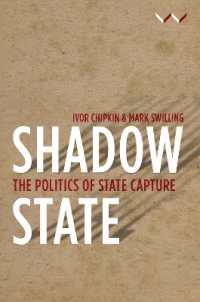Full Description
In the nineteenth century, American and British culture experienced an explosion of interest in writings about the brain. The years between 1800 and 1880 are often described as the emergence of modern neuroscience, with new areas of the brain being discovered and named. Naming was quickly followed by a drive to hypothesize functioning, a process that suggested thinking itself may be a mere physiological act. In Writing the Brain, Stefan Schöberlein tracks how literature encountered such novel, scientific theories of cognition-and how it, in turn, shaped scientific thinking.
Before the era of modern psychology, a heterogeneous group of alienists, self-help gurus, and anatomists proposed that the structure of the brain could be used to explain how the mind worked. Suddenly, nineteenth-century readers and writers had to contend with the idea that qualities once ascribed to disembodied souls may arise from a mere lump of cranial matter. In a period when scientists and literary writers frequently published in the same periodicals, the ensuing debate over the material mind was a public one. Writing the Brain demonstrates, by examining several canonical works and textual rediscoveries, that these exchanges not only influenced how poets and novelists fictionalized the mind but also how scientists thought and talked about their discoveries. From George Combe to Charles Dickens, from Emily Dickinson to Pliny Earle, from Benjamin Rush to Alfred Tennyson, 1800s debated what it means to have or, rather, be a brain.
Contents
Acknowledgements
The First Century of the Brain: An Introduction
Chapter 1. Nature's Mind and Mind's Nature: Romantic Cognition Between Harp and Atom
Harp-Strings
Mind-Strings
Mind-Matter
Mind-Atoms
Chapter 2. Split Brains, Doubled Minds: The Gothic's Bicameral Vision
The Sleepers
Dialoging the Self
Hemispheric Voices
Master-Minds
Chapter 3: Skulls and Society: Reading the Mind as a Multi-Organ Entity
Brain-Damage
Phrenology as Sociology
Phrenological Victorianism
Phrenological Americanism
Phrenology's Real
Chapter 4: Cranial Reconstruction: Racialized Brains and the Psychometric Real
Uncommon Minds
Great Brains
A Cranial Case Study
Realism as Psychometry
Chapter 5: Rattle-Brained: Insanity as Material Metacognition
You, Me, Brain
Metempsychosis as Metacognition
Insanity as Pop Culture
Psychosis as Metacognition
Chapter 6: The Telegraphed Brain: Wires as Proto-Neurons
Thoughts on Wires
Telegraphed Minds
Introspective Brain-Machines
Afterword
References
Index




